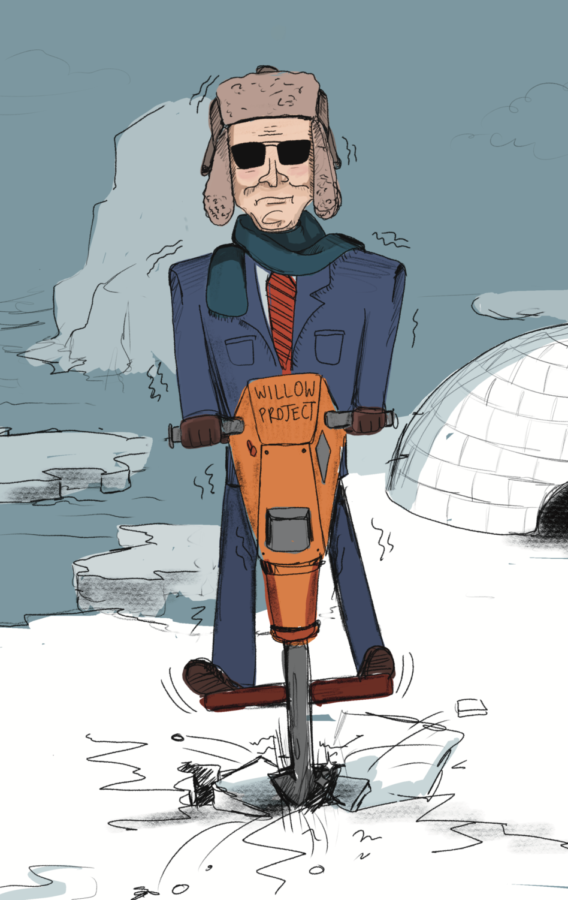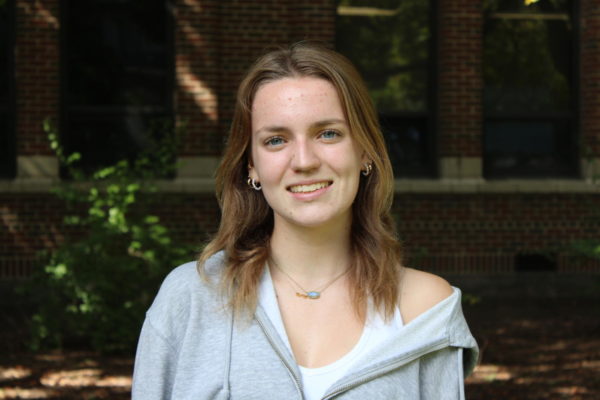Opinion | Willow Project will have detrimental effects to our environment
April 20, 2023
I’ve always had a love for animals. Growing up, I would spend hours watching Animal Planet, captivated by the lives of arctic animals. A memorable image for me will always be polar bears. Seeing them excitedly play in the water and then nestle next to each other to keep warm was like looking into a whole new world, and it was heartbreaking to see their homes get destroyed. Yet these fascinating images are now frequented with scenes of despair. The once snowy bears are now wandering their iceless habitats in search of food. We all are aware that climate change is a problem that will not just affect our generation, but all the generations to come, but we choose to ignore it. And now, we have a new problem on our hands: The Willow Project. We can no longer sit back and watch the devastating effects on our planet; we have to make a change to stop it.
The Willow Project, recently approved by the Biden administration on March 13, is a massive oil drilling venture in Alaska that has been proposed by an energy company called Connoco Phillips. According to CNN, “The Biden administration felt its hands were tied with the project because Conoco has existing and valid leases in the area.” Since the project’s approval, a lot of complaints have arisen from various environmental groups. EarthJustice, an environmental law group, is expected to make an objection to the project and, hopefully, stop it from moving forward. The area where the project is planned holds up to 600 million barrels of oil, so drilling this project will have severe consequences to our climate.
The Biden Administration gave its formal approval of the project on March 13th. “By the administration’s own estimates, the project would generate enough oil to release 9.2 million metric tons of planet-warming carbon pollution a year – equivalent to adding 2 million gas-powered cars to the roads.”
Additionally, on top of its impact on the planet as a whole, Alaska is a pristine habitat for wildlife that has lots of wilderness protection. Drilling there would cause detrimental effects to the animals living there. Natalie Dawson, executive director for Audubon Alaska, an organization dedicated to conserving the natural ecosystems in Alaska highlights these effects. “The Willow project raises a number of serious issues, including impacts to migrating caribou, anadromous fish, and nesting Yellow-billed Loons”.
Recently, the Willow Project’s approval has triggered a lot of online activism, including more than one million letters written to The White House opposing the project and multiple protests, but it was still approved.
Even with an issue that seems so disconnected from ETHS and the Evanston community at-large, we still must take actions into our own hands. AP Environmental Science teacher Ellen Fierrer explains what Evanstonians can do to make a change.
“In AP Environmental Science, we talk a lot about the impact of things we do individually but also as a community,” Fierrer says. “So, we look towards how the city of Evanston is making sure that we’re resilient and sustainable with less carbon emissions for less of an impact on climate change.”
As a rather progressive city, the City of Evanston has done just that by approving the Climate Action and Resilience Plan (CARP), which calls for zero waste and carbon neutrality by 2050, as well as 100 percent renewable energy by 2030. CARP plans to combat climate change by implementing waste reduction, building energy efficiency and climate-friendly transportation.
Eliminating single-use products would be a great step in the right direction. CARP wants to require food retailers to use biodegradable, compostable or recyclable packaging in Evanston by 2025. Additionally, ETHS has also started to act on food waste.
“A big part of greenhouse gasses are from food waste. The school has been working on making sure our food is composted versus going into landfill, because if we have food products that go into landfill, it will produce a lot of methane. And methane is actually a stronger greenhouse gas than [carbon dioxide],” Fierrer notes.
While paying attention to where our food waste goes is an essential part of reducing greenhouse gas emissions, Evanston buildings contribute even more emissions.
As CARP explains, “In Evanston, 80 percent of greenhouse gas emissions come from existing buildings.” In order for Evanston to meet CARP’s goals of hitting carbon neutrality, existing buildings will have to make huge reductions in their consumption of energy and their greenhouse gas emissions. To combat this, the Evanston City Council approved the energy and water benchmarking ordinance, which requires large buildings in Evanston to report their annual energy and water usage. Since the biggest portion of emissions come from buildings in Evanston, it is crucial that we continue to focus on reaching net-zero emissions as a community.
Another important area to focus on is transportation. Although electric vehicles (EVs) are very expensive, they have many advantages to reduce carbon emissions that make them a great option for those that can afford it. According to CARP, EVs are extremely energy efficient, because they convert energy from the grid to their wheels by 40 percent more than conventional vehicles from gasoline to energy. As a result, with just one dollar, EVs can travel more than twice as far as a gasoline-powered vehicle. Since the home installed charging stations can be expensive, Evanston has installed eight stations that provide EV charging for free. Another plus side is that EVs emit no direct air pollutants and no emissions overall if the energy is from wind and solar power. Unfortunately, the energy grid in the midwest is also powered from coal and natural gas, so those power plants may still emit air pollutants. Overall, electric vehicles are a great opportunity for clean transportation, and CARP should continue this by implementing electric energy into public vehicles like CTA buses and city vehicles to make it more accessible to all Evanston citizens.
Admittedly, clean energy is expensive, but Fierrer highlights ways to make a change in your own home.
“I would recommend moving to electrification to stop combusting fossil fuels. The system that we live in doesn’t actually let us do that easily, but those who have the ability to change things in their home can use Community Solar from Illinois,” she says.
The City of Evanston formed the CS2 Residential Community Solar Program, which partnered with the MC-Squared Energy Services to make clean energy available to small businesses and Evanston residents when they subscribe. Those participating in the program are then able to support solar energy projects without having to install their own rooftop panels. This is a great option for people willing to subscribe because it’s an easy way to support clean energy from sources here in Illinois.
Since Community Solar still costs money, focusing on energy usage in general is something that we should all strive to work towards. According to statistics from Direct Energy, heating and air conditioning takes up 46 percent of total energy consumption and water heating takes up 14 percent in the average household. Furthermore, Direct Energy recommends that you keep your house at 78 degrees in the summer and 65 degrees in the winter to save the most energy. Although that might be a different temperature than most households are used to, it is critical that we make these changes for the better.
While ETHS has started to put guidance for composting and recycling in place at school, we can also focus on it at home. For those willing to pay for a composting service, they will pick up all food waste and compostable products from your home and take them to a composting site. All of those food scraps will then become a nutrient-rich soil, instead of just sitting in a landfill. If you don’t want to spend the money, backyard composting is another option. It is a tricky process because you have to get the right amount of greens—grass clippings, fruits and vegetables—as well as browns—leaves and twigs—but the ability to make use of items that would otherwise be in a landfill is a great benefit to the environment.
The Willow Project is a huge problem that will not have a simple solution, but focusing on changes we can make as a community in Evanston and as individuals will help to mitigate the disastrous effects of the project. Our city has already made significant progress by establishing CARP and educating students on global warming in classes like AP Environmental Science.
“I can say that as someone who’s been in this bubble for a very long time we have already made huge strides. I’m extremely hopeful in the changes that can be made and I just see a lot of promise in the future,” Fierrer concludes.











Vivien Bissell • Apr 20, 2023 at 9:05 am
I’m so glad someone said something about this!